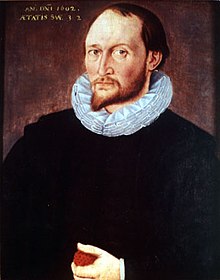Thomas Harriot
| Thomas Harriot | |
|---|---|

Portrait often claimed to be Thomas Harriot (1602), which hangs in Oriel College, Oxford.
|
|
| Born |
c. 1560 Oxford, England |
| Died | 2 July 1621 (aged 60–61) London, England |
| Citizenship | English |
| Fields | Astronomy, mathematics, ethnography |
| Alma mater | St Mary Hall, Oxford |
| Known for |
|
Thomas Harriot (Oxford, ca. 1560 – London, 2 July 1621) — or spelled Harriott, Hariot, or Heriot — was an English astronomer, mathematician, ethnographer, and translator. He is sometimes credited with the introduction of the potato to the British Isles. Harriot was the first person to make a drawing of the Moon through a telescope, on 26 July 1609, over four months before Galileo.
After graduating from St Mary Hall, Oxford, Harriot travelled to the Americas, accompanying the 1585 expedition to Roanoke island funded by Sir Walter Raleigh and led by Sir Ralph Lane. Harriot was a vital member of the venture, having translated and learned the Carolina Algonquian language from two Native Americans, Wanchese and Manteo. On his return to England he worked for the 9th Earl of Northumberland. At the Earl's house, he became a prolific mathematician and astronomer to whom the theory of refraction is attributed.
Born in 1560 in Oxford, England, Thomas Harriot attended St Mary Hall, Oxford. His name appears in the hall's registry dating from 1577.
After his graduation from Oxford in 1580, Harriot was first hired by Sir Walter Raleigh as a mathematics tutor; he used his knowledge of astronomy/astrology to provide navigational expertise, help design Raleigh's ships, and serve as his accountant. Prior to his expedition with Raleigh, Harriot wrote a treatise on navigation. In addition, he made efforts to communicate with Manteo and Wanchese, two Native Americans who had been brought to England. Harriot devised a phonetic alphabet to transcribe their Carolina Algonquian language.
...
Wikipedia
